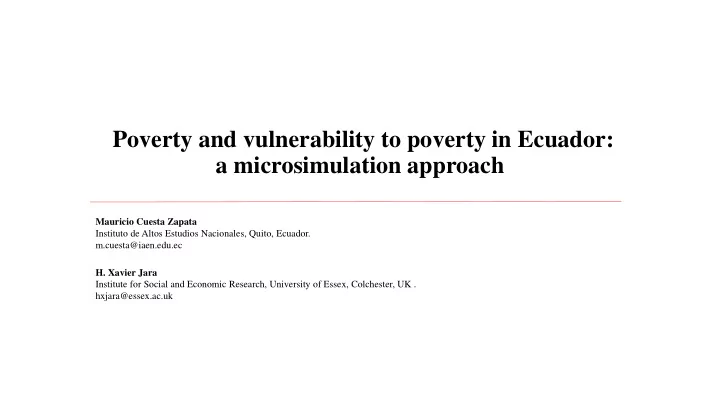

Poverty and vulnerability to poverty in Ecuador: a microsimulation approach Mauricio Cuesta Zapata Instituto de Altos Estudios Nacionales, Quito, Ecuador. m.cuesta@iaen.edu.ec H. Xavier Jara Institute for Social and Economic Research, University of Essex, Colchester, UK . hxjara@essex.ac.uk
Motivation • Over time people might flow in and out of poverty as a result of adverse economic shocks • The concept of vulnerability to poverty considers the probability of being affected by such shocks • In developing countries, vulnerability to poverty is often not considered due to data limitations
Poverty ex-post measure of deprivation of some of life’s basic needs, such as food, shelter, clothing, education, health care and social security among other dimensions of wellbeing Vulnerability ex-ante measure of the person's well-being, which reveals future expectations and risks of their realization: loss of production, price increase, illness, unemployment
Vulnerability ( v h,t ) = β α ≤ β α Pr ( , , , ) | ( , , , ) v c x e z c x e + + , 1 , 1 , h t h t h h t h t h h t current consumptio n future consumptio n where, x is a vector of observable household characteristics h β describes the state of the economy t α time invariant household level effect, and h e , idiosyncratic factors (shocks) h t
( ) [ ] = = Pr ( ), ( ) v become poor f E c V c + + , , 1 , 1 h t h t h t This would be done using longitudinal data (where the same households are tracked over a number of periods) of sufficient length Using cross-sectional data we estimate using a three-step feasible generalized least squares (FGLS). (Amemiya, 1977).
Methodology • We use ECUAMOD, the tax-benefit microsimulation model for Ecuador • ECUAMOD uses household representative microdata from the National Survey of Income and Expenditures of Urban and rural Households 2011/2012 for 39,617 households and 153,341 individuals
Estimation strategy We estimate poverty and vulnerability to poverty by constructing a series of repeated cross-sections for years 2011 to 2016 using ECUAMOD based on ENIGHUR 2011/2012 • No large labour market changes over this period • Focus on the role of the tax-benefit system
The typical household head (HHH) Female Male Age median age (years) 50 45 Education not completed primary 29% 20% primary 23% 29% ethnicity Mestizo 79% 79% Indigenous 6% 7% Marital status Separated 32% Widowed 27% Married 57% Single 34% Social security No social security 68% 57% Social security general 24% 32%
The tax policy benefits Social insurance contribution Share of paid taxes 70% 100% 90% 58% 90% 60% 80% 50% 70% 60% 40% 50% 30% 40% 18% 30% 20% 9% 20% 6% 10% 4% 2% 2% 3% 10% 2% 1% 1% 1% 1% 0% 0% 1% 0% 1% 1% 0% 0% 1 2 3 4 5 6 7 8 9 10 1 2 3 4 5 6 7 8 9 10 Poorest Richest Poorest Richest Decile Decile
The tax policy benefits Simulated Benefits 100% 92% 88% 90% 78% 80% 69% 70% 61% 60% 43% 50% 40% 31% 30% 15% 20% 3% 10% 1% 0% 1 2 3 4 5 6 7 8 9 10 Poorest Richest Decile
The vulnerability results Standard N Mean Minimum Maximum deviation poor-no-vulnerable 15% 93,2 38,7 0 155,5 poor-vulnerable 20% 89,9 37,4 0 155,3 no-poor-vulnerable 25% 340,6 240,8 155,61 2.296 no-poor-no-vulnerable 40% 512,2 844,4 155,55 31.544
Poverty and vulnerability to poverty 40% 34.7% 33.8% 32.7% 35% 32.6% 31.5% 30% 11% 11% 9% 9% 8% 25% 20% 15% 23% 24% 24% 24% 23% 10% 5% 0% 2012 2013 2014 2015 2016 No poor and vulnerable Relative poverty (disposable income < realtive poverty line) Total HHH population to be assisted (poor+vulnerable)
Concluding remarks • Microsimulation techniques can be used to estimate vulnerability to poverty based on cross-sectional data • In Ecuador: • Around 20% of the population is identified as poor and vulnerable • Around 25% of the population is identified as non-poor but vulnerable
Next steps • Exploit the advantages of ECUAMOD to simulate the effect of increasing benefit amounts for certain population groups: • Poor and vulnerable • Non-poor but vulnerable • Account for changes in the labour market in a rigorous way (e.g. as in nowcasting exercises using EUROMOD)
ECUAMOD
Recommend
More recommend